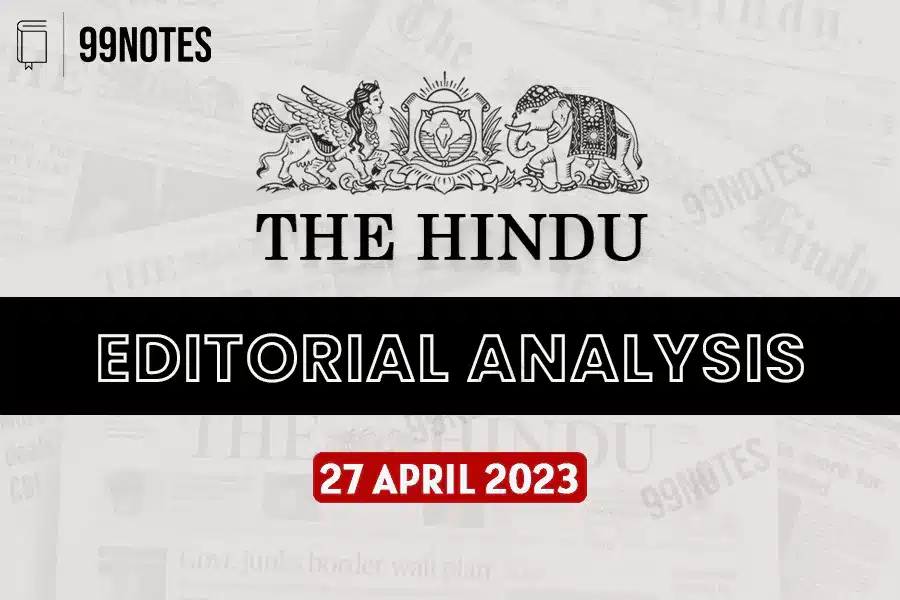27 April 2023 : The Hindu Editorial Analysis
Rajasthan proposes Gig Workers (Registration and Welfare) Bill, 2023.
Context
- The gig economy is a significant source of employment for youth and migrant workers in India.
- Lack of recognition and benefits has led to harsh working conditions, including low pay, long working hours, and job insecurity.
- The Rajasthan government has proposed the Gig Workers (Registration and Welfare) Bill, 2023, to address these issues.
- The bill will create a welfare board that will design policies and hear the grievances of gig workers on a piece-rate basis.
- The success of this proposed bill could lead to similar measures being implemented in other states to ensure the welfare of gig workers.
What is the gig economy?
- The gig economy is a term used to describe a growing trend in which individuals perform short-term or freelance work (or “gigs”) facilitated through online platforms or mobile applications.
- These jobs can range from driving for ride-sharing services and delivering food or goods to providing professional services such as writing, graphic design, or web development.
- Gig workers are paid per gig rather than receiving a salary or traditional benefits.
Importance of Gig Economy in Workers
- Flexibility: It provides flexible work arrangements for individuals who may not be able to or prefer not to work traditional full-time jobs.
- Opportunities beyond the boundaries of countries: There are no geographical limitations on gig workers – they can perform freelance work for any client from any country.
- It gives an opportunity to businesses to access a wider pool of talent.
- Businesses can scale up or down their workforce more quickly in response to market demand.
- Promotion to Innovation and Entrepreneurship: the gig economy can encourage entrepreneurship and innovation by allowing individuals to pursue their passions.
- Helps reduce unemployment: people can turn their skills into income-generating opportunities.
Challenges:
- Job insecurity: Gig workers lack job security and can face unpredictable work schedules, leaving them vulnerable to income instability and financial stress.
- Lack of benefits: Gig workers do not get traditional employment benefits such as healthcare, paid time off, or pension, leaving them without adequate social security protection.
- Exploitation : Some gig workers can be exploited by their employers – who may not provide adequate compensation.
- Inconsistent income: Gig workers often experience unpredictable work schedules and income fluctuations, making it difficult to plan for the future or maintain financial stability.
- Social isolation: Gig workers often work alone and have limited opportunities for collaboration or social interaction with colleagues.
Way Forward:
- Provide benefits: Governments and companies can work together to provide gig workers with benefits – such as healthcare, paid time off, and retirement savings plans, that are typically offered to full-time employees.
- Improve job security: Governments should introduce regulations requiring companies to offer their workers more secure work arrangements, such as minimum hours or contracts. The step taken by the Rajasthan government in this regard is praiseworthy.
- Address exploitation: Governments can enforce labour laws and regulations that protect gig workers from exploitation and abuse by their employers.
- Social support: arrangements should be made to reduce their social isolation by providing opportunities for gig workers to build networks and connect with other employees.
The challenge of reviving a sense of fraternity.
Introduction
- The Constitution of India was drafted by the Constituent Assembly.
- N. Roy proposed the idea of drafting the Constitution in December 1934.
- It became an official demand of the Indian National Congress in 1935 and was officially adopted in the Lucknow session in April 1936.
Common brotherhood:
- R. Ambedkar pointed out a cavity in the draft of the Constitution regarding the principle of fraternity during the concluding session of the Committee on November 25, 1949.
- Fraternity means a sense of common brotherhood among all Indians, which gives unity and solidarity to social life.
- Fraternity is closely linked to social solidarity, which cannot be achieved without public empathy.
- The fraternity was added to the principles of liberty, equality, and justice in the Preamble. Still, it needed to be sufficiently clarified that it enriches and strengthens the gains from the other three.
- The idea of fraternity must be remembered in the Constitution and electoral
- Acharya Kripalani pointed out that the Preamble’s contents have legal and political principles and moral, spiritual, and mystical content.
- Democracy must be lived as a moral principle and not just a legal and constitutional device – otherwise, it can turn into autocracy, imperialism, or fascism.
A Duty:
- The principle of fraternity needs to be clearly defined in the Constitution of India – although Article 51A(e) mentions the duty of every citizen to promote harmony and the spirit of common brotherhood among all the people of India.
- Fraternity can be both an emotion and a principle, but it is often used to denote feeling rather than principle.
- There is a need to distinguish between the psychological fact of common emotion and the political principle of fraternity or cooperation.
- There is a pressing need to excavate the moral values embedded in the Constitution of India, identify their connections, and determine their coherent or not-so-coherent world-views.
Virtual Digital Assets: India’s Stand and Way Ahead.
Introduction:
- A progressive regulatory framework could establish India’s virtual digital assets leadership.
- Rulemaking is complex and can result in unintended consequences, especially in the context of rapidly evolving technologies.
The approach of the Government of India:
- India recently extended anti-money laundering provisions to virtual digital assets businesses and service providers under the Prevention of Money Laundering Act (PMLA) Act of 2002.
- The extended activities include the exchange between virtual digital assets and fiat currencies, transfer of virtual digital assets, safekeeping or administration of virtual digital assets, and participation in and provision of financial services related to virtual digital assets.
- Extending anti-money laundering provisions to virtual digital assets in India is a positive step towards regulating the sector.
- It provides a framework for monitoring and preventing malpractices, promotes transparency, and builds confidence in the ecosystem.
- The risk-mitigation measures adopted by India to regulate virtual digital assets are consistent with global guidelines set forth by the International Monetary Fund and the Financial Action Task Force (FATF).
Conclusion:
- The G-20 finance track leads discussions on creating a global regulatory framework for virtual digital assets.
- India’s leadership and experience can play a crucial role in establishing a global regulatory framework for virtual digital assets while also considering the measures taken by other G-20 nations, such as Japan and South Korea.
The Third-Gen web is about the public good.
Introduction
- India’s focus on digital public infrastructure and IoT in rural development creates opportunities for deploying Web 3 in rural areas.
- The U.S.- India Strategic Partnership Forum states that the third-gen web will be crucial for India to realise its $1.1 trillion digital asset opportunity by 2032.
What is Web 3.0?
- Web 3.0 is the next generation of the internet, where data is decentralised and stored on a blockchain, enabling greater security, privacy, and transparency in online transactions and interactions.
- It is envisioned as a more intelligent, interconnected, and autonomous web that relies on technologies such as artificial intelligence, the Internet of Things (IoT), and blockchain.
Potential Benefits to India
- Web3 platforms can help India’s handcraft industry secure design-related innovations through digital tokens.
- This can improve the economic potential of artisans and artisan communities across India, particularly in the north-east, western and peninsular regions.
- Web3 instruction tools can rapidly disseminate grassroots innovations among artisans, fostering knowledge sharing and collaboration.
- India has experienced a rapid rise in community data, an essential aspect of its recent transformation. However, much of this data is not used to improve systemic efficiency and results.
- Web3 can extract insights from large volumes of community data generated by IoT-enabled development programs like the Jal Jeevan Mission.
- Web3’s analytics at the edge can be used to map water usage habits of communities and improve early warning systems for floods – this way, Web3 can have a transformative role in regionally disadvantaged areas.
Way Forward:
- Current data analytics capabilities could be improved to catch up with the pace of data generation in rural areas.
- India has a pool of talent in data analytics and web design, which can be incentivised to work for the benefit of rural communities through Web3.
- India’s National Blockchain Strategy 2021 proposes exploring tokenisation and blockchain solutions for development programs.



